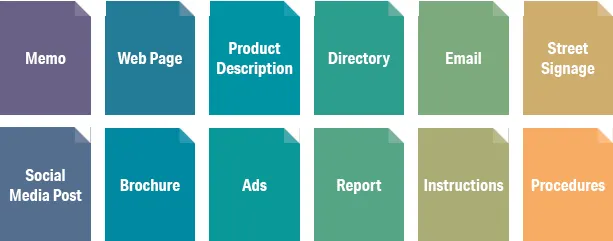Have you ever tried to explain to someone how to tie their shoes? It’s much harder than it seems. You’ve been tying your own shoes since kindergarten and now can do it without thinking. In order to show someone else how to do it, however, you have to take what has become automatic and break it down into small steps in a specific order. This process takes mental dexterity. You have to imagine yourself in someone else’s place to be able to teach them how to tie their shoes. If you do your job well, you help them build a new skill and prevent them from tripping over untied laces. Shoe tying and technical communication may seem like two very different activities, but we offer this analogy to help you understand your role as a technical communicator.
Technical communicators help audiences solve problems and break complex topics down into simple steps. That’s why you’re reading this book. In the pages that follow, you will learn how technical communication shares similarities with the shoe-tying situation. The ability to explain with clarity is crucial on the job, whether you work for a government think tank, an engineering firm, or a preschool. What’s more, you can apply these skills at any stage in your professional development.
You might be nervous about a course in technical communication because you think the word “technical” implies learning complicated and tedious material. You might have avoided or postponed taking a course in technical communication, assuming that the skills aren’t necessary for your chosen field. This textbook aims to show you that technical communication isn’t hyper-specialized, impractical, or intimidating. Think about your field. Training to be a professional means you are training how to be a problem solver. Technical communication is about communicating the most direct and effective path toward a solution. Employers and organizations tackle issues, and they need people with advanced communication skills who can translate ideas into plain English.
Technical Communication Defined
Technical communication involves generating clear, precise, and accurate content about practical information in a field. A technical communicator creates a purposeful message for a specific audience. This can take many forms (figure 1.1).
Although written content is one method used by technical communicators, it’s not the only one. You’ll notice that technical communication is also about formatting, layout, and visual design, not just words on a page. As a result, this book uses the phrase “technical communication” instead of “technical writing.” This textbook introduces you to diverse approaches to technical communication and a range of communication skills that will be useful in any profession.
Technical documents—the content generated by technical communicators—surround you. For example, a bus stop contains specific information relevant to users of public transportation. Riders need to sort through arrival and departure times quickly and efficiently so they don’t miss their bus. Effective design organizes the information: the location of bus stops, the route schedule, and connection points with other bus lines. When a document like this fails to do its job, the consequences are real.
Start noticing where and how technical documents intersect with your life. You’ll begin to see examples everywhere. Store directories, the washing label sewn inside your shirt, heating instructions for a microwave dinner—these are technical documents, too. As simple as these examples sound, they didn’t just happen. Someone thought about you, the user, when they designed the mall kiosk to help you get to that out-of-the-way shop that sells pickle-flavored lip balm. The icons on your favorite shirt’s label tell you at a glance how to wash it so it lasts longer. Dinner is saved—as well as your taste buds—by instructions that tell you to let the microwaved mashed potatoes sit for five minutes before shoveling them into your mouth.
Depending on your field, a technical document may have a different name: deliverable, product, report, text, etc.
Technical communicators are a diverse group. Look around and you’ll see several majors represented in your classroom. You might have classmates studying computer science, engineering, business, education, medicine, or human services. Technical communicators could be teachers who provide student reports for extra instructional assistance, nurses who write detailed patient summaries to ensure continuity of care during shift changes, or engineers who create product or process schemas.
This book teaches you how to solve technical problems by focusing on the following concepts in your writing:
» The audience’s attributes (the “user”)
» The purpose of the document
» The message that will resolve the problem
Effective technical communication involves creativity, discipline, and resourcefulness. Wherever you might be headed after this, you are responsible for using the tools described in this book to make someone’s life easier and, sometimes, safer.


